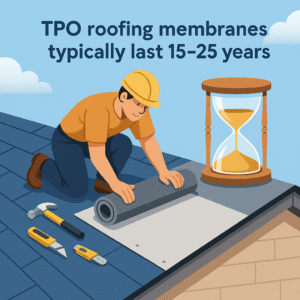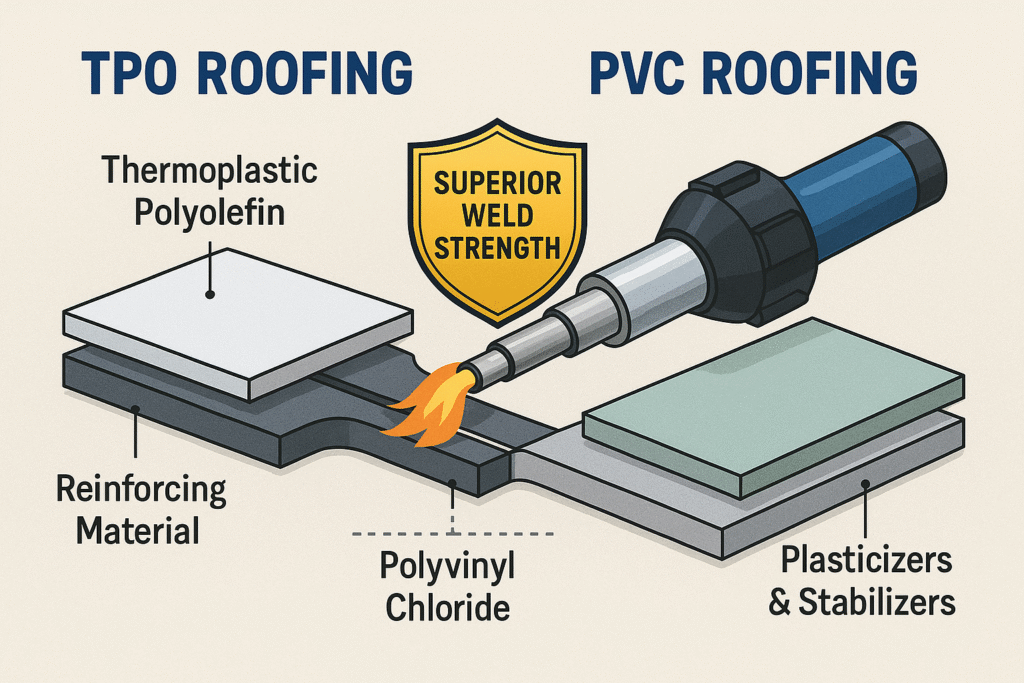- Written by: admin
- August 1, 2025
- Categories: Uncategorized
When selecting the best roofing system for your commercial building, choosing between TPO vs PVC roofing represents one of the most critical decisions you’ll make. Both single-ply membrane systems offer exceptional performance, but understanding their key differences will help you make an informed choice for your roofing project.
Understanding TPO and PVC Roofing
TPO (Thermoplastic Polyolefin) and PVC (Polyvinyl Chloride) roofing systems are leading single-ply roofing membranes designed specifically for commercial applications. These roof materials have revolutionized the commercial roofing industry by providing durable, energy-efficient solutions that outperform traditional roofing options.
TPO membrane consists of a single-ply membrane made from thermoplastic materials, offering excellent flexibility and heat-welding capabilities. The tpo roofing system provides a cost-effective solution for commercial buildings while maintaining superior performance standards.
PVC roofing systems feature polyvinyl chloride compounds that create incredibly durable roof membranes. These PVC membranes are known for their exceptional chemical resistance and long-term reliability, making them a preferred choice for buildings exposed to harsh environmental conditions.
Why TPO and PVC Are Popular in Commercial Roofing
The popularity of TPO and PVC roofing materials stems from their superior performance characteristics compared to traditional roofing options. Commercial roofing contractors increasingly recommend these single-ply membranes because they:
– Provide excellent energy efficiency through reflective surfaces that reduce cooling costs
– Offer superior durability with resistance to puncture, UV rays, and extreme weather
– Enable faster installation through heat-weld technology that creates seamless joints
– Require minimal maintenance throughout their extended lifespan
– Support foot traffic when properly installed and maintained
Both TPO and PVC roofing systems represent advanced thermoplastic technologies that have proven their worth across countless commercial roofing projects. The roofing process for both materials involves precise installation techniques that ensure optimal performance for decades.
What Is the Difference Between TPO and PVC Roofing?
Understanding what is the difference between TPO and PVC roofing requires examining their material composition, performance characteristics, and application suitability. While both are single-ply roofing membranes, they exhibit distinct properties that make each suitable for different situations.
Material Composition Differences:
– TPO roofing consists of thermoplastic polyolefin compounds combined with reinforcing materials
– PVC roofing utilizes polyvinyl chloride with plasticizers and stabilizers for enhanced flexibility
– Both materials can be heat-welded, but PVC offers superior weld strength
Performance Variations:
– PVC is more resistant to chemicals, grease, and fire
– TPO roofing is generally less expensive than PVC while providing excellent basic protection
– Light-colored TPO and white PVC both offer exceptional reflectivity
Pros and Cons of TPO Roofing
TPO Roofing Advantages:
- Cost-Effective Solution – TPO roofing costs significantly less than PVC systems, making it an attractive option for budget-conscious projects
- Energy Efficiency – Reflective surfaces reduce cooling costs and improve building performance
- Flexible Installation – TPO membranes accommodate building movement and thermal expansion
- Environmental Benefits – Recyclable materials support sustainable building practices
- Proven Performance – TPO systems have demonstrated reliability across diverse climatic conditions
TPO Roofing Disadvantages:
- Variable Quality – TPO products from different manufacturers may exhibit inconsistent performance
- Limited Chemical Resistance – Less resistant to oils, greases, and certain chemicals compared to PVC
- Potential Shrinkage – Some TPO membranes may experience slight shrinkage over time
- Installation Sensitivity – Requires experienced roofing crews for optimal results
Pros and Cons of PVC Roofing
PVC Roofing Advantages:
- Superior Chemical Resistance – PVC roofing is known for exceptional resistance to acids, oils, and industrial chemicals
- Fire Resistance – Excellent fire-resistant properties provide enhanced building safety
- Long-Term Durability – The Average lifespan of PVC roofs often exceeds 20-30 years
- Excellent Weld Strength – Heat-welded seams create virtually waterproof connections
- Proven Track Record – Decades of successful installations demonstrate reliability
PVC Roofing Disadvantages:
- Higher Initial Cost – PVC roofing requires a greater upfront investment than TPO systems
- Installation Complexity – PVC roofing requires skilled installation teams familiar with proper techniques
- Plasticizer Migration – Over time, plasticizers may migrate, potentially affecting membrane flexibility
- Environmental Concerns – Manufacturing process and disposal considerations require careful evaluation
TPO vs PVC Roofing: Head-to-Head Comparison
Comparing TPO vs PVC roofing systems requires examining multiple performance factors that impact long-term value and building protection. This comprehensive comparison will help you understand which roofing option best suits your specific needs.
Durability and Lifespan
PVC roofing systems offer superior longevity, with properly installed systems lasting 20-30 years or more. The chemical composition of PVC membranes provides exceptional resistance to environmental stressors, including UV radiation, extreme temperatures, and chemical exposure.
installed systems lasting 20-30 years or more. The chemical composition of PVC membranes provides exceptional resistance to environmental stressors, including UV radiation, extreme temperatures, and chemical exposure.
TPO roofing membranes typically last 15-25 years, depending on product quality and installation standards. While TPO roofs last slightly less than PVC systems, they still provide excellent value through their lower initial cost and reliable performance.
Energy Efficiency and Reflectivity
Both roofing systems excel in energy efficiency through their reflective surfaces. TPO and PVC look similar in their ability to reflect solar radiation, reducing cooling costs by up to 30% compared to traditional dark roofing materials.
Key Energy Benefits:
– High solar reflectance index (SRI) ratings
– Reduced urban heat island effect
– ENERGY STAR® certification available for both systems
– Significant cooling cost savings throughout the roof’s lifespan
Chemical and Fire Resistance
PVC is more resistant to chemicals, oils, and grease, making it the preferred choice for restaurants, manufacturing facilities, and buildings with rooftop equipment that may leak fluids. The superior chemical resistance of PVC roofing systems makes them ideal for demanding commercial applications.
Fire resistance represents another area where PVC roofing excels. PVC membranes are inherently fire-resistant and often achieve higher fire ratings than TPO systems, providing enhanced building safety.
Installation and Repair
Both single-ply membrane systems utilize heat-welding technology for seam installation, but the roofing process differs slightly:
TPO Installation:
– Generally faster installation due to material flexibility
– Requires precise temperature control during welding
– Compatible with various insulation systems
– Suitable for most commercial roofing contractors
PVC Installation:
– Requires more specialized installation techniques
– Superior weld strength when properly installed
– More forgiving during the welding process
– Benefits from experienced PVC installation teams
Cost Comparison
TPO roofing costs typically range 15-25% less than comparable PVC systems, making TPO an attractive option for cost-conscious projects. However, the choice for your roofing needs should consider long-term value rather than just initial cost.

Total Cost Factors:
– Initial material and installation costs
– Long-term maintenance requirements
– Energy savings throughout the roof’s life
– Expected lifespan and replacement timing
Environmental Impact and Sustainability
Both roofing offers environmental benefits through energy efficiency and recyclability. TPO roofing is a single-ply system that typically uses fewer chemicals in manufacturing, while PVC roofing is also recyclable at the end of its service life.
Sustainability Features:
– Cool roof technology reduces energy consumption
– Recyclable materials support circular economy principles
– LEED points available for both systems
– Reduced environmental impact compared to traditional roofing
Best Use Cases for TPO vs PVC
Choose TPO when:
– Budget constraints require cost-effective solutions
– The building has minimal chemical exposure risks
– Standard commercial applications without extreme conditions
– Energy efficiency is the primary concern
Choose PVC when:
– Building requires superior chemical resistance
– Maximum durability and lifespan are priorities
– Fire resistance is a critical safety requirement
– Long-term value justifies a higher initial investment
Comparison Table: PVC vs TPO Roofing at a Glance
Feature | TPO Roofing | PVC Roofing |
Initial Cost | Lower | Higher |
Lifespan | 15-25 years | 20-30+ years |
Chemical Resistance | Good | Excellent |
Fire Resistance | Good | Superior |
Energy Efficiency | Excellent | Excellent |
Installation Complexity | Moderate | Higher |
Maintenance Requirements | Low | Low |
Environmental Impact | Good | Good |
What to Consider Before Choosing TPO or PVC Roofing
Whether TPO or PVC represents the better choice depends on several building-specific factors that require careful evaluation by a qualified commercial roofing company:
Budget Considerations:
– Available capital for initial investment
– Long-term maintenance budget planning
– Energy savings projections
– Expected return on investment timeline
Building Requirements:
– Roof slope and drainage considerations
– Structural load capacity
– Existing roofing system compatibility
– Access requirements for maintenance
Environmental Factors:
– Local climate conditions
– Chemical exposure risks
– Fire safety requirements
– Energy efficiency goals
Why Choose Roofing San Jose for TPO or PVC Roofing?
Selecting the right commercial roofing contractor is just as important as choosing between TPO and PVC roofing systems. Roofing San Jose provides comprehensive single-ply membrane installation services backed by extensive experience and local expertise.
Certified TPO and PVC Roof Installers
Our roofing crews maintain manufacturer certifications for both TPO and PVC roofing systems, ensuring your installation meets the highest quality standards. We understand the nuances of comparing TPO vs PVC roofing and help clients make informed decisions based on their specific requirements.
Our Certification Advantages:
– Factory-trained installation teams
– Access to premium roofing materials
– Manufacturer warranty backing
– Ongoing technical support and training
Local Knowledge and Roofing Expertise
As an established commercial roofing company in the San Jose area, we understand local building codes, climate considerations, and permitting requirements. Our experience with both TPO and PVC roofing materials ensures optimal system selection and installation for your specific building needs.
Local Expertise Benefits:
– Climate-specific material recommendations
– Expedited permitting and inspection processes
– Rapid response for maintenance and repairs
– Established relationships with local suppliers
Conclusion: PVC vs TPO Roofing – Which Should You Pick?
Choosing the best roofing system between TPO versus PVC roofing ultimately depends on your specific building requirements, budget constraints, and long-term performance expectations. Both single-ply roofing membranes offer excellent value, but understanding their differences enables informed decision-making.
Consider TPO roofing when budget efficiency and proven performance meet your building’s needs. TPO systems provide excellent energy efficiency and durability at a lower initial cost, making them ideal for standard commercial applications.
Select PVC roofing when maximum durability, chemical resistance, and fire safety are priorities. While PVC roofing may require a higher initial investment, the superior performance characteristics often justify the additional cost through extended lifespan and reduced maintenance requirements.

